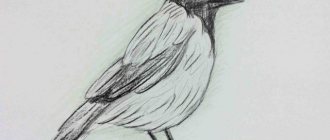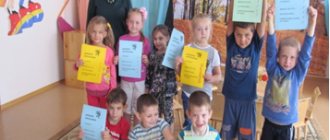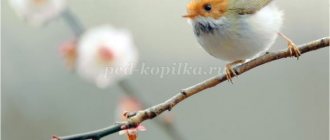Summary of a lesson on speech development in the senior group “Birds of Migratory”
Maria Shandybo
Summary of a lesson on speech development in the senior group “Birds of Migratory”
Summary of a lesson on speech development in the senior group of compensatory orientation for children with speech impairments
Topic: “Birds of Migratory”
Software tasks:
1. Activation of the dictionary on the topic “Migratory birds”.
2. Practical learning by children of the names of bird body parts.
3. Learn to compose simple common and complex sentences with subordinate clauses.
4. Agreement of adjectives with nouns in gender and number.
5. Practical mastery of the skill of forming complex adjectives.
6. Teach the practical use of prefixed verbs in speech (flew out, flew around, flew in.) and prepositions (from-, in-, above, under-, to-, from-).
7. Practicing the correct use of nouns in the dative and prepositional cases.
8. Teach children to compose descriptive stories according to the plan given by the speech therapist.
9. Development of visual perception, auditory attention and memory in children.
10. Correction of fine motor skills.
11. Development of logical thinking in children.
Progress of the lesson:
1. Organizational moment.
The one who correctly names one after another “chain of words” will sit down: swallow-stork-rook; starling-swan-crane; stork-swan-swallow.
2. Goal setting, activities.
Today we will talk about birds.
3. Game “Fold it correctly” (cut-out pictures depicting migratory birds).
Name who is in your pictures. (Rook, starling, swallow, stork, crane, swan).
-Who is this? How to call it in one word?
-These are birds.
-What birds? Migratory or wintering?
-Why are birds called migratory?
-Birds fly to warmer regions in the fall and return back in the spring.
-Why do birds fly to warmer regions?
-Because in winter it’s cold and there’s no food.
-Which birds fly to us first?
-Rooks and starlings.
4. Game “Select, name, remember”
We will name words - signs characteristic of each bird that answer the question: “Which one?”, “Which one?” You can also name complex words consisting of two words.
a) rook (what,.
black, small, smart, noisy, useful, loud, black-eyed,
sharp-billed, swift-winged;
b) swallow (what...
small, dexterous, cheerful, beautiful, agile, caring, smart, black-winged, white-breasted;
c) starling (which one).
small, black, shiny, beautiful, singing, smart, sharp-beaked,
loud-voiced;
d) stork (which one).
big, white, smart, strong, caring, black-eyed; black-winged,
leggy;
d) crane (which one).
big, gray, strong, beautiful, long-legged, sharp-beaked;
e) swan (what).
big, snow-white, beautiful, proud, caring, waterfowl,
long-necked
5. Treats for birds.
Connect the bird with its favorite food with a string.
-What will you give to the birds?
-I'll give the starling a worm. -Crane - frog. - Stork-frog. - Swan-fish.
-Rook-worm. -Cuckoo caterpillar. - Swallow-mosquito.
6. “Excursion to the park.” The sound of birds singing.
-What did you hear?
-Birdsong.
7. Practicing prefixed verbs “Bird in the nest.”
-What is the bird doing?
-Bird from the nest. flew out. Around the nest. flew around. Above the nest. flew by. Through the nest. flew over. To the nest. flew up. Under the nest. flew by. To the nest. arrived.
9. Physical exercise. Game "Hungry Chicks".
The mother bird has flown away. The first group of children (chicks) are sitting in the kids looking for beetles. nest, and the second group (mothers) fly, looking for food. The little chicks are waiting for food. Then they change roles. Mom's gifts.
10. Compiling a short story - a description according to the plan given by the speech therapist. Birds want us to write a story about them, and pictures will help us with this
- assistants. You must name the bird, what it looks like, what it eats, where it lives.
-I want you to tell me about the swallow.
-Swallow is a small and beautiful bird. She has a small black head
black back. The wings and tail are black. The swallow's breast is white and red.
blue tie. She has short legs. The swallow flies very quickly because
that she has long, strong, sharp wings. The tail is also long and strong,
forked. The swallow feeds on small insects, flies, mosquitoes, and
nest under the roof of a house.
Riddle about the stork.
This is an old friend of ours
He lives on the roof of a house
He flies to hunt
For frogs to the swamp.
-This is a stork. It is white. It has black feathers on its wings. It has a large red beak, a long neck, and long legs. The stork feeds on frogs, snakes, grasshoppers, and builds a nest on the roofs of wooden houses and trees.
11. Game “Fourth is odd”.
-Which picture is the odd one out? Starling, magpie (wintering, swallow, rook. Stork, crane, swan, turkey (domestic). Swallow, starling, stork, cuckoo (does not build nests).
12. Are birds beneficial?
-Destroy plant pests in fields and vegetable gardens, orchards and forests.
RESULT OF THE LESSON
-Who did we talk about today?
-About migratory birds, about the benefits they bring.
LEXICAL TOPIC “MIGRATION BIRDS”.
https://www.liveinternet.ru/users/4619293/post215385271/
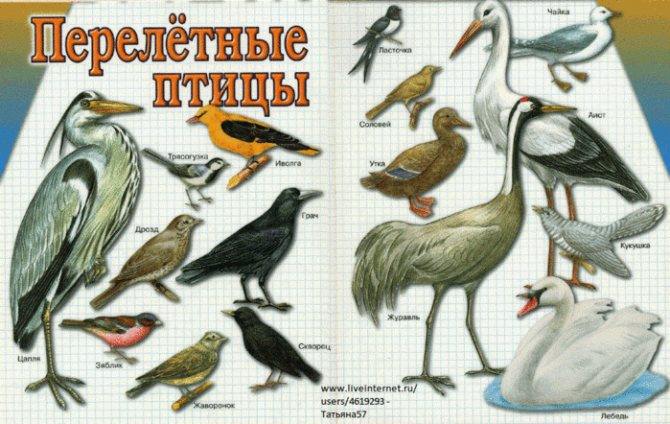
CHILDREN SHOULD KNOW THE NOUNS: rook, starling, swallow, swift, cuckoo, crane, geese, swans, lark, thrush, nest, birdhouse, male, female, chicks, eggs, singer, insects, larvae, plumage, flock, countries, legs , neck, wing, eyes, tail, beak, head, stork, heron.
VERBS: fly, fly away, arrive, return, build, clean, set aside, curl, hatch, hatch, feed, grow up, get stronger, squeak, sing, curl, leave, say goodbye, gather, eat, peck, destroy, curl, nip, glue, blind.
ADJECTIVES: big, small, singing, black, warm (edges), white, striped, caring, busy, spring, strangers, fluffy, ringing, field, distant, beautiful, long-legged, waterfowl, agile, vociferous.
LET'S TELL ABOUT BIRDS. Migratory birds are birds that fly from us in the fall to warmer regions. These birds are insectivores (eat insects) and feed on insects.
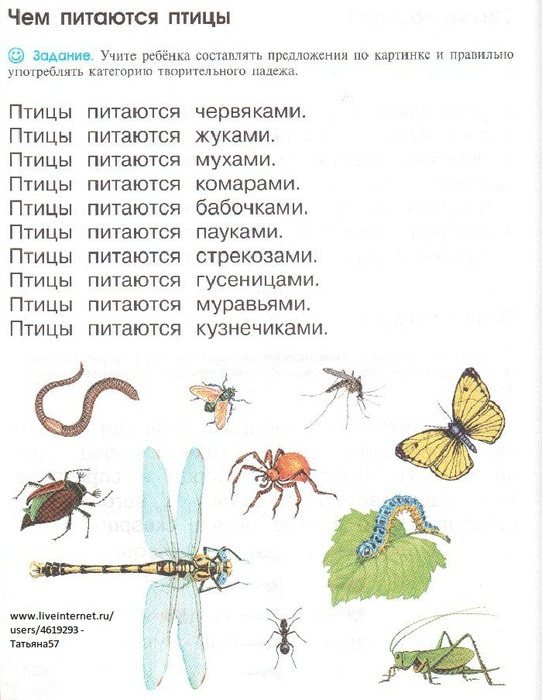
In the fall, insects hide, the birds have nothing to eat, so they fly away.
Ducks, geese and swans fly away in a line - a string.

Swallows and starlings fly away in a flock.
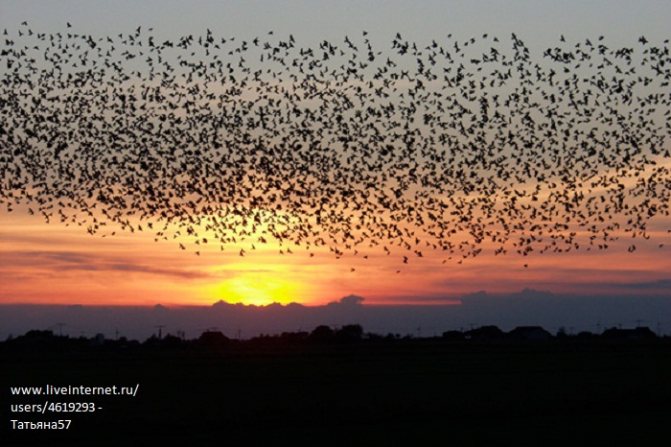
Cranes fly away in a wedge - an angle.
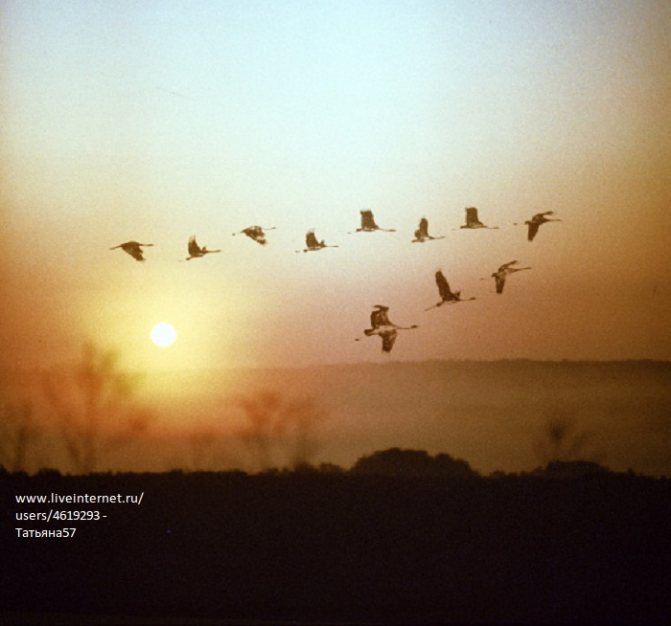
And the cuckoos fly away one by one. In spring, migratory birds return to us.
Birds have a head with a beak, a body with two wings, two legs with claws, a tail and plumage.
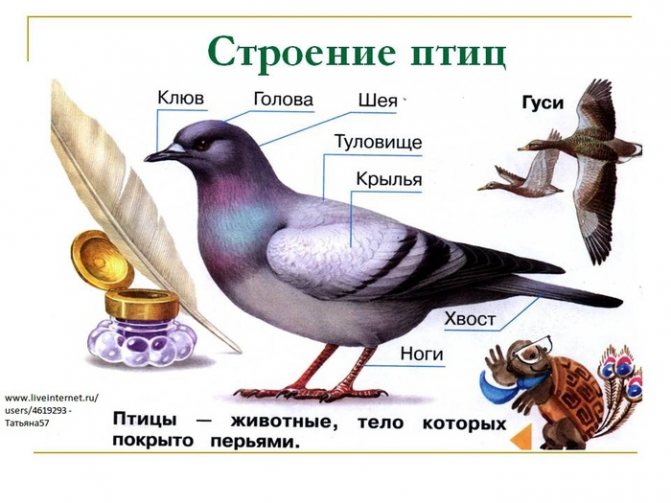
CHILDREN SHOULD BE ABLE TO IDENTIFY EXCESS AND EXPLAIN: WHY? Magpie, crow, tit, swallow (swallow is a migratory bird, the rest are wintering). Lark, sparrow, rook, starling. Crow, duck, dove, sparrow. Rook, tit, swallow, cuckoo. Magpie, sparrow, woodpecker, swift. Dove, swan, heron, crane.
Beetle, butterfly, chick, mosquito (chick is a bird, other insects).
CORRECTLY NAME CHICKENS: Cranes are crane babies. Rooks - rooks. Geese are goslings. Starlings are starlings. Ducks -…. Cuckoos - ... . Swifts - ... .
CORRECTLY ANSWER THE QUESTIONS: WHOSE? WHOSE? WHOSE? WHOSE? Whose beak? The crane has a crane-like appearance. The goose has goose. The duck has…. The cuckoo has…. The rook has….
ONE IS MANY. Cuckoo - cuckoos. Crane - cranes. Starling - starlings. Nightingale - nightingales. Lark - larks. Swan - swans. Rook - rooks. Duck - ducks. Swallow - swallows. Rook - rooks. Stork - storks. Gosling - goslings.
WHO VOICES: The cuckoo cuckoos. The swallow is chirping. The starling sings. The crane is cooing. The duck quacks. The goose cackles.
DESCRIBE AND COMPARE BIRDS ACCORDING TO PLAN: Wintering or migratory bird? Why are they called that? Appearance (tail, head, wings, body, beak, feathers, colors...) What does it eat? Where he lives - a hollow, a birdhouse, a nest...
COMPILATION OF A DESCRIPTIVE STORY. The rook is a black bird with a white beak. The rook has a head, body, wings, tail, and paws. The bird's entire body is covered with feathers. In the spring, rooks fly from warm countries, build nests and hatch chicks - rooks. Rooks feed on insects, worms and plant seeds. In the fall, when it gets cold, rooks gather in flocks and fly away to warm countries until spring. Rooks help humans; they destroy insects and caterpillars - pests of fields and vegetable gardens.
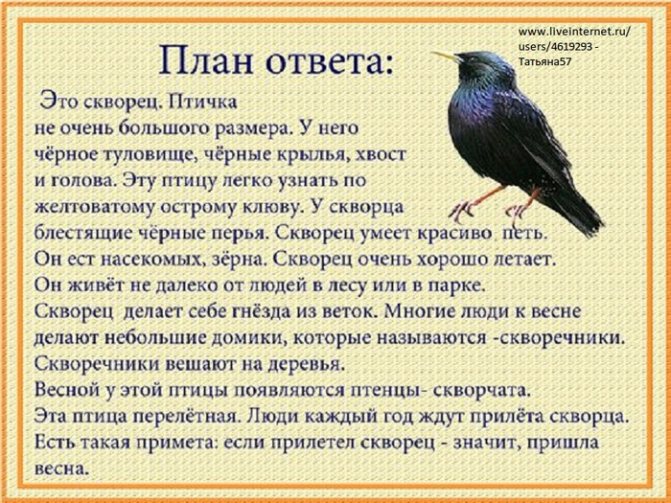
The grass is turning green, the sun is shining, the Swallow is flying towards us in the canopy in the spring. With her, the sun is more beautiful and spring is sweeter... Say hello to us from the road as soon as possible. I’ll give you grains, and you sing a song that you brought with you from distant lands. (A. Pleshcheev)
SAY A WORD. There is a palace on the pole, in the palace there is a singer, and his name is ... (starling).
CALL IT TENDINGLY: Nightingale - nightingale. Crane - crane. Swan - swan...
WHO has WHO? The cuckoo has a cuckoo, cuckoo. The crane has a baby crane, crane babies. The starling has a little birdling, starlings. The swan has a baby, swans. The rook has a rook, rooks. The duck has a duckling, ducklings. The stork has a baby stork, baby storks. The goose has a gosling, goslings.
END THE SENTENCE WITH THE WORDS “LONG-LEGGED CRANE”: In the field I saw ... (long-legged crane). I watched for a long time... (long-legged crane). I really liked this beautiful and slender... (long-legged crane). I wanted to approach... (long-legged crane). But he got scared and flew away. He flew beautifully, spreading his wings and circling in the sky... (long-legged crane). I told my mother about... (long-legged crane). Mom said that you shouldn’t come up and scare... (the long-legged crane). I promised my mother not to approach... (the long-legged crane) anymore. Now I will only watch from afar... (long-legged crane).
CHOOSE THE PREPOSITION RIGHT BY MEANING (FROM, IN, TO, OVER, ON, ON): The rook flew out... nest. The rook has arrived... nest. The rook flew up... to the nest. The rook is circling... with his nest. The rook sat down... on a branch. The rook walks ... arable land.
WE IMPROVE THE ABILITY TO RELL.
RETELL THE STORY ACCORDING TO THE QUESTIONS: The rooks have arrived. The rooks arrive first. There is still snow all around, but they are already here. The rooks will rest and begin to build nests. Rooks build nests on the top of a tall tree. Rooks hatch their chicks earlier than other birds.
Which birds arrive first in spring? What do the rooks immediately begin to do? Where do they build their nests? When do they hatch their chicks?
Harbingers of spring. The cold winter has passed. Spring is coming. The sun is rising higher. It heats up more. The rooks have arrived. The children saw them and shouted: “The rooks have arrived! The Rooks Have Arrived!"
What was the winter like? What comes after winter? How does the sun warm in spring? Who has arrived? Who did the children see? What did they shout?
RETELL THE STORY IN THE FIRST PERSON: Sasha decided to make a birdhouse. He took boards, a saw, and sawed the planks. From them he put together a birdhouse. The birdhouse was hung on a tree. May the starlings have a good home.
COMPLETE THE SENTENCE: There is a nest on the tree, and on the trees... (nests). There are branches on the branch, and on the branches... . There is a chick in the nest, and in the nests - .... There is a tree in the yard, and in the forest - ....
GUESS THE RIDDLES: Without hands, without an axe. A hut has been built. (Nest.)
He appeared in a yellow fur coat, Goodbye, two shells. (Chick.)
There is a palace on a pole, There is a singer in the courtyard, And his name is... (Starling.)
White-billed, black-eyed, He walks importantly behind the plow, Finds worms and beetles. A faithful watchman, a friend of the fields. The first harbinger of warm days. (Rook.)
READ THE POEMS ABOUT BIRDS, LEARN ONE OF THEM BY MORE. Starlings. We even got up at night and looked out of the window into the garden: Well, when, well, when will our guests arrive? And today we looked - a starling was sitting on an alder tree. They arrived, they arrived,
We've finally arrived!
